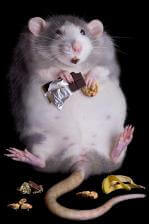Can You Be Addicted to Food?
The cookies lure you to the cupboard with a siren song. Chocolate seems as vital as oxygen. Can you be addicted to food? The answer points to a force greater than willpower alone. Guest author Dr. Ellen Hendriksen explains
Ellen Hendriksen, PhD

The evidence is leaning in favor of yes (sort of). It’s not the same strength of addiction as hard drugs like crystal meth or cocaine, of course, and many other factors come into play with food, like positive associations, habit, and social pressure. It’s also important to note that true addiction is a very complex disease, with roots in genetics, family environment, and individual behavior. But anyone who can’t stop the motion of fork to mouth knows that there’s more to food addiction than simply a weak will.
I’ve certainly never met anyone coming down from a broccoli high, but there are certain foods that have addictive potential, namely sugar, fat, and salt. Chocolate is common culprit due to the one-two punch of fat and sugar.
How Does Food Addiction Work?
How does the food version of addiction work? Let’s use its more intense cousin, drug addiction, to demonstrate.
Along with several other natural substances, at the core of it all is a natural, made-in-the-body neurotransmitter called dopamine, or the “pleasure chemical.” Alcohol, gambling, and natural rewards like sex and—surprise!—food, affect the release of dopamine. Drugs of abuse do this the most effectively. Dope equals dopamine.
We’ll borrow the brain of a formerly heroin-addicted patient as an example; we’ll call him Brian. Whenever Brian used heroin, dopamine surged from specific cells and was dumped into the synapses of his brain, causing a high. This was such a dramatic, jolting change that his brain scrambled to adapt and adjust. One way his brain compensated was to reduce the number of dopamine receptors. Then, because there were fewer receptors, Brian needed more of the drug next time to get the same effect.
Dopamine is released only by a small number of brain cells, but each of these cells connects, like an electrical grid, to thousands of other brain cells, so dopamine’s influence is far-reaching. Over time, the connected regions of Brian’s brain began to change in response to his drug-taking, such as those in charge of learning, decision-making, and memory.
Eventually, Brian experienced powerful cravings for the drug. He used a lot of it—called bingeing—when he could get it. He needed more of it over time to get the same effect, called tolerance, and he went into withdrawal, or experienced physical symptoms, when he couldn’t get it. Finally, because of the changes in the brain, he experienced cross-sensitization, or a heightened reaction to similar drugs, as well. The result: Brian was an addict.
But what about food? The late Princeton University psychology professor Bart Hoebel, Ph.D., devoted much of his career to determining that sugar is addictive, at least in rats. Other studies have demonstrated similar results with fat and salt, but let’s look more closely at sugar as an example…
A Sugar High

After a month on this schedule, the rats showed the 4 symptoms characteristic of addiction. First, they binged, meaning when they finally had access to the sugar water, they drank unusually large amounts. Second, they exhibited signs of withdrawal, indicated by tremors, staying in a dark corner of the cage, and reacting passively to stress. Third, they showed cravings, as measured by working very hard to get the sugar after a period of deprivation and consuming more than ever before when they finally got it. Finally, when deprived of sugar, they chose instead to ingest an alcohol solution, showing cross-sensitization.
Drugs, of course, create a much bigger effect, but the process of the brain becoming addicted to its own dopamine is essentially the same. It’s a jump from rats to humans, but here are 5 take-home lessons from our furry friends:
How to Beat a Food Addiction
- Mom was right when she told you that breakfast is the most important meal of the day. So eat breakfast, preferably with protein. Your risks of bingeing on fat, salt, or sugar is high when you’re famished or feeling deprived, so eat regularly.
- In the case of sugar, trade your soda for water. Notice I said water, not diet soda. Fake sugar disrupts the body’s innate ability to regulate intake of sweet foods and has, counter-intuitively, been linked to obesity. If you miss the fizz, try sparkling water. If you miss the caffeine, coffee, which has its detractors and supporters (such as Nutrition Diva), is still better than soda.
- Shake up your habits. If that sleeve of cookies calls you to the kitchen after dinner, stay out of the kitchen during your danger times. Take yourself for a walk, seek out company to support and distract you, or do some evening errands.
- Experiment with abstinence versus moderation. For some, cutting out problem foods entirely is the best solution. For others, to avoid a feeling of deprivation, moderation is the way to go. Work with your own personality to find what works for you.
- If food is controlling you and your life, seek help. Frustrations with food can run the gamut from occasional “stress eating” to a diagnosable eating disorder like Binge Eating Disorder or Bulimia. Find a qualified mental health provider whom you like and trust.
Lastly, forgive yourself if you slip up. It takes time—sometimes a long, frustrating time—to change your brain back. Enlist the help of those closest to you and ask them not to tempt or shame you. Partner up with a friend who is also trying to cut back. Eventually, you’ll feel more comfortable around fat, salt, or sugar. And that, my friends, is sweet.
References
Davidson TL, Swithers SE. 2004. A Pavlovian approach to the problem of obesity. International Journal of Obesity and Related Metabolic Disorders, 28(7): 933-35.
Avena NM, Rada P, Hoebel BG. 2008. Evidence for sugar addiction: Behavioral and neurochemical effects of intermittent, excessive sugar intake. Neuroscience and Biobehavioral Reviews, 32(1): 20-39.

Dr. Ellen Hendriksen is a clinical psychologist at the Stanford University School of Medicine. Ellen graduated from Brown University, earned her Ph.D. at UCLA, and completed her training at Harvard Medical School. In her clinic, she treats everything from depression to trauma to panic, but she has a special place in her heart for anxiety disorders. Ellen is also an active research scientist and develops therapy programs for individuals and families living with chronic illness. She lives in the San Francisco Bay Area with her husband and two sons, ages 5 and 2.
;
Mouse and evil cupcake photos courtesy of Shutterstock.

